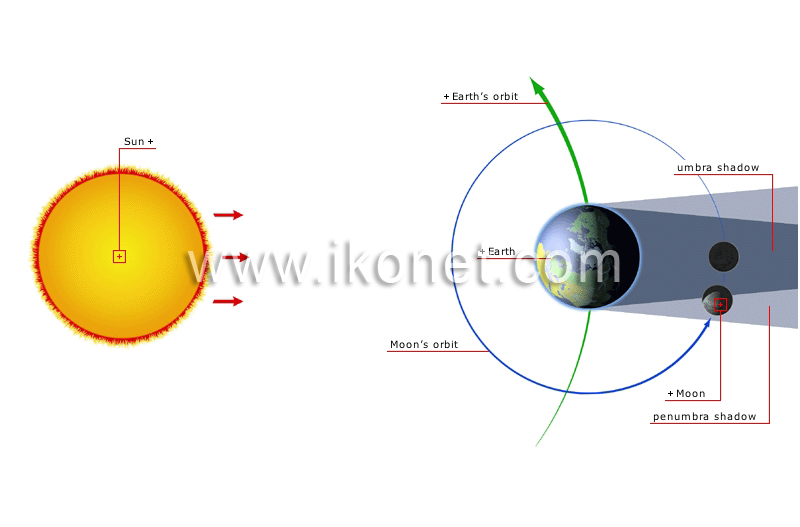
The Moon, our own natural satellite
The Moon is Earth’s only natural satellite. Our planet’s trusty companion is an airless, silent world without any signs of life. Because of its small size, the Moon’s force of attraction is too weak to hold the gases it would need to form an atmosphere. Without a layer of air, the Moon cannot trap the Sun’s heat to warm it at night or protect itself from too much heat during the day. This makes the Moon’s nights freezing cold and its days extremely hot. The lunar landscape has not changed much in thousands of years. The many craters that dot its surface are scars from meteorites that hit the Moon early in its history. The Moon’s vast plains are large craters filled with lava, which came out of cracks in its crust. Around these plains are hills and mountain ranges. In other craters, which are never lit, several probes have detected frozen water from comet impacts.
Where does the Moon come from?
By analyzing the lunar rock samples brought back by astronauts, scientists have been able to piece together the Moon’s history. According to a theory that is generally accepted today, the Moon was created as a result of a violent collision between young planet Earth and an asteroid the size of Mars. The impact hurled massive amounts of rock from Earth and from the shattered asteroid into space. Under Earth’s force of attraction, the rock fragments began to circle around our planet, eventually joining together to form the Moon.

Destination: the Moon
On July 21, 1969, a human being stepped onto the surface of the Moon for the first time. The man was Neil Armstrong, member of the Apollo 11 mission. Following this memorable date, five other missions touched down on the Moon. In all, a dozen astronauts have visited our natural satellite. They have taken many photographs, conducted a variety of scientific experiments, and collected close to 880 pounds (400 kg) of lunar rocks. Many countries plan to construct a permanent lunar base that will serve as an astronomical observatory, research laboratory and launching site for future flights to Mars and beyond. To this day, the Moon is the only celestial body that has been visited by humans.
Earth viewed from the Moon
Viewed from the Moon, Earth appears four times as large as the Moon does when it’s viewed from our planet. Earth is also 60 times brighter. The lack of atmosphere on the Moon allows astronauts to observe our own beautiful blue and white planet with amazing clarity. Members of the Apollo missions have said that watching Earth rise in the Moon’s dark sky was a spectacle of extraordinary beauty.
The man in the Moon
With a bit of imagination, it’s possible to see a face when looking at the Moon with the naked eye. That is why people often say that there is a man in the Moon. The dark spots make up the eyes, the nose, and the mouth. These dark spots are, in fact, the Moon’s huge, dusty plains. Early astronomers once thought these plains were seas, and so they named them Ocean of Storms, Sea of Tranquility, and Lake of dreams. The rest of the man’s face is formed by the Moon’s hills and mountain ranges.
Moon phases
Next to the Sun, the Moon is the brightest object in the sky. However, it does not produce light by itself the way the Sun does; instead it acts like a mirror, reflecting light from the Sun. Night after night, the Moon seems to change its shape in the sky, turning from a thin crescent into a full circle. While the Moon travels around Earth, the Sun lights the satellite’s surface, either partially or fully. These different faces, which are called Moon phases, follow a cycle that lasts 291/2 days.
Lunar eclipses: a spectacular disappearing act
Lunar eclipses have been observed since the beginning of time. The cause of these phenomena was first described by the Greek philosopher Thales about 2,600 years ago. A lunar eclipse occurs when Earth passes between the Moon and the Sun. The Moon falls entirely under Earth’s shadow and is plunged into darkness. Eclipses of the Moon happen more often than eclipses of the Sun. Unlike solar eclipses, however, lunar eclipses can be observed safely with the naked eye.

The Moon’s force of attraction
Even though the Moon’s gravity is six times weaker than Earth’s, its force of attraction is powerful enough to pull water from Earth’s oceans up toward itself. The “bulge” or “swelling” that occurs in the ocean is called a high tide. At the same time, water is drawn away from the beaches on each side of the bulge, producing a low tide in those areas. The oceans that are facing away from the Moon also experience the same effects. That is why tides occur twice a day, as an ocean faces the Moon and as it faces away from the Moon. When the Sun and the Moon are aligned in a straight line with Earth, the tides reach their maximum height. These kinds of tides are called spring tides and occur when there is a new or a full moon.

Also see:
- "Astronomy" section in the Visual Dictionary
- "Earth" in the Visual Dictionary
- The galaxies
- Meteorites: these stones fallen from the sky




